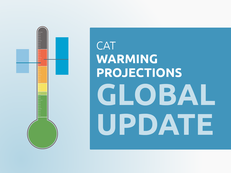Publications
Paris Agreement in force, but no increase in climate action
The rapid entry into force of the Paris Agreement has created the legal basis for countries to increase their level of action and ambition to meet the 1.5degC warming limit over the next two years in the lead-up to 2018. The Climate Action Tracker (CAT) has evaluated the starting point read more...
Constructing the future: creating a Paris Agreement-proof building sector: analysis
The building sector accounts for around 20% of climate-changing emissions, and its energy demand is likely to double by mid-century without action, according to a Climate Action Tracker (CAT) analysis released today.While the technologies required to make new buildings zero-emissions are all available, the sector is not taking up those read more...
Zero emission vehicles need to take over car market to reach 1.5°C limit: analysis
Zero-emission vehicles need to reach a dominant market share by around 2035 for the world to meet the Paris Agreement’s lower warming limit of 1.5°C—and even that could be too late to avoid the need for significant negative emissions, according to new analysis by the Climate Action Tracker (CAT).This transformation read more...
Paris Agreement: near-term actions do not match long term purpose - but stage is set to ramp up climate action
From the perspective of the Climate Action Tracker, the Paris Agreement will positively influence the world’s ability to limit the adverse effects of climate change.For the first time, an international climate agreement has, at its core, a goal to not just hold warming below 2°C, but critically specifies this goal read more...
Climate pledges will bring 2.7°C of warming, potential for more action
With 158 climate pledges now submitted to the UN, accounting for 94% of global emissions, the Climate Action Tracker today confirmed this would result in around 2.7°C of warming in 2100 – if all governments met their pledge. “This level of warming is still well above the agreed limit of read more...
How climate change mitigation makes economic sense
There are strong immediate and domestic incentives to undertake greater mitigation efforts to limit global warming to 2°C, or to 1.5°C as many governments are calling for.Existing mitigation targets can be met and, in most cases, can be strengthened in a more cost-effective manner by properly accounting for the value read more...
Comparison between Climate Action Tracker and MIT “Energy and Climate Outlook 2015” assessments
The Climate Action Tracker estimates a median global warming of 2.7°C above pre-industrial by 2100, assuming full implementation of targets and policies proposed in INDCs from 1 October 2015, and of 3.6°C taking only the policies that governments have actually implemented at a national level.The MIT Energy and Climate Outlook read more...
What do the CAT, UNFCCC Synthesis Report and the UNEP 2015 Emissions Gap report say about the prospects of limiting warming to below 2°C and 1.5°C from INDC levels for 2025 and 2030
The Climate Action Tracker (CAT), the UNFCCC Synthesis Report and the UNEP 2015 Emissions Gap Report (EGR) (to which the CAT had an input) estimate global emission levels by 2025 and 2030 from Intended Nationally Determined Contributions (INDCs) submitted as of 1 October 2015, and compare these to levels required read more...
Faster and Cleaner: Decarbonization in the Power and Transport Sectors Is Surpassing Predictions
The transition from fossil fuels to cleaner, safer energy technologies is underway and offers hope for limiting warming to 2°C. This study by ClimateWorks, NewClimate Institute, Ecofys, and Climate Analytics compares past projections with actual developments in renewable energy, coal consumption, and passenger vehicles. Decarbonization of the power sector is read more...
The Coal Gap: planned coal-fired power plants inconsistent with 2°C and threaten achievement of INDCs
If all coal plants in the pipeline were to be built, by 2030, emissions from coal power would be 400% higher than what is consistent with a 2°C pathway, according to a new analysis released by the Climate Action Tracker at the Paris Climate Summit today.Even with no new construction, read more...
Stay informed
Subscribe to our newsletter

